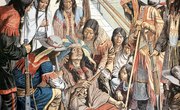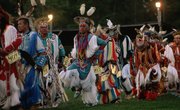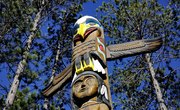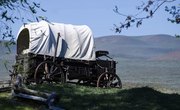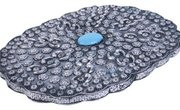The Chinook Indians are a Native American tribe with origins in the Pacific Northwest along the Columbia River. Related to the Clatsop tribe of northwestern Oregon, the Chinooks were known historically for their fishing, canoe building and navigation skills. In the early 1800s, when Lewis and Clark encountered them, the Chinooks numbered only 400. They lived communally in well-built wooden plank houses and traded goods with seafaring British and American merchants. Although much of the tribe succumbed to European diseases such as smallpox, influenza and malaria, the surviving Chinook generations endured. Today there are approximately 2,700 Chinook Indians, including those who occupy the Quinault Reservation in Washington State.
Chinook Indian Domestic Life
For food, Chinooks traditionally lived on fish and wild game, often smoked or dried, supplemented by root vegetables and berries. They also roasted their fare over an open fire and steamed shellfish in wooden containers or covered baskets. Domestic implements of the Chinooks included handmade knives, chisels, drills, awls and hammers. To split wood, they used wedges made from elk antlers. To catch fish, they used nets and wooden spears with chiseled stone points, as well as sinkers and anchors shaped from rocks. They made clothing and textiles with sewing needles fashioned out of bird bones or wood. Chinooks wore elk hides, fur robes, woven hats, capes, rain cloaks and blankets. Some Chinook garments were crafted from dried bear grass or cedar bark.
Chinook Indian Beliefs
Although similar to other Pacific Northwest aboriginals, Chinook Indians had their own cultural heritage and beliefs. Their religious tradition consisted of a spiritual mythology based on protective spirits and animal deities, such as the blue jay and coyote. Chinooks had faith in the guardian spirit concept, a common belief among Native Americans that powerful spirits guided and protected them. Chinooks did not carve totem poles like other natives in the region, but did produce handmade effigies, dance rattles, sticks and boards inscribed with spiritual icons. They also painted images of spirits on canoes and around house doors, symbolizing divine protection. In Chinook society, religious functions were performed by shamans, including ceremonies, incantations and offerings.
Chinook Indian Traditions
Because of their success in fishing, hunting, fur trapping and trading with foreigners, the Chinooks were a relatively wealthy tribe. Those with high social status held slaves -- often captured members of other tribes. To signify aristocracy and free status, Chinooks flattened the foreheads of infants using cradleboards. These ancient traditions are no longer practiced. Present-day Chinooks keep other traditions alive by holding yearly events, including a winter gathering, story get-together, tribal meeting, canoe journey, county fair and seafood dinner. Before the annual meeting, Chinooks hold a first salmon ceremony, in which the bones of the season's first salmon are taken out to the Columbia River in a gesture of gratitude and respect. They also maintain the Chinook language and traditions of canoe building, wood carving and basket weaving.
Chinook Indian Weapons
As Lewis and Clark observed, the Chinook Indians were by and large a peaceful people. Still, because they lived well and enjoyed an abundance of salmon, crustaceans and shellfish, they had to be on the alert for plunderers. They also had to defend and uphold the exclusive right to their fishing waters, beaches and riverbanks. Chinook men fought tribal enemies with bows, arrows, spears and double-edged wooden clubs. To protect themselves, they wore thick armor made from elk skins. They posted lookouts to keep watch for intruders who came by canoe in an attempt to rob their food stores. While the Chinooks shared food peacefully with explorers and traders, they took up arms and became fierce warriors when assailed by enemies.
Related Articles
References
Writer Bio
Shannon Leigh O'Neil, a New York City-based arts and culture writer, has been writing professionally since 2008. Her articles have appeared in "GO Magazine," "The New York Blade" and "HX Magazine," as well as online media. O'Neil holds a Master of Arts in modern art history from the City College of New York, where she also studied French and minored in classical languages.



